
Gary Bassett and his wife, Kristin, make frequent visits to the orchard during harvest season to snap photos for their Facebook and Instagram pages. Those pages are primary drivers of traffic to the orchard. (Photo by Leslie Mertz)
After 20 years in the information-technology (IT) industry, Gary Bassett decided to leave his desk job and corporate politics behind and start up a small apple orchard outside the north central Ohio town of Beaverdam.
Rather than completely shunning the tech world, however, he is trying a pick-your-own approach that takes advantage of social media and e-payment capabilities to draw a tech-savvy and frequently young customer base. And it seems to be working.
Agriculture is not new to Bassett, who holds a bachelor’s degree in agronomy and ran his own turf-grass maintenance company for nearly two decades before transitioning to IT. “In the 1980s, the microcomputer was invented and I was enamored with it,” he said. During the winters when the turf grass was dormant, he threw himself into computing, eventually acquiring the programming skills to write customized software programs for his business. After training his employees on the programs and watching one after another move on to lucrative IT positions, he decided to follow suit, quitting the turf business and taking a corporate IT job.
It didn’t take long for him to see the downside of office life. “The entire time, I’d look out the window and think, ‘I wish I was out there.’ I could picture someone finding me at my desk one day, forehead down on my keyboard, and the letter Y running across my screen,” he remembered.

Kristin Bassett slices into one of the 30-plus varieties at the orchard. The orchard specializes in unusual varieties, such as Nova Spy, Freedom, Liberty and Snow Sweet. (Photo by Leslie Mertz)
Inspiration struck seven years ago. He approached his father, who has a 300-acre farm, and asked to lease a small unused section to plant an apple orchard. His father agreed, and Bassett put his first trees in the ground, naming the plot Sugar Creek Orchard. As the trees grew, so did Bassett’s desire to get out of the office and back to the land. In 2016, he left his full-time corporate job and turned his attention to the 10-acre orchard, which by then was ready for its first full harvest.
That fall, Bassett and his wife did all of the harvesting themselves, as well as polishing, boxing and selling their apples at farmers’ markets and at a roadside stand next to the orchard. “I really wasn’t satisfied with the amount of money we made, and it was one heck of a lot of work,” he says. After some reflection, they decided to try a completely pick-your-own operation in 2017. The idea was to make the harvest far less work-intensive for them, eliminate the need for cold storage to house already-picked-but-unsold fruit, and provide an enjoyable experience for the public. “The thing was, I had no pick-your-own clientele,” he said
What he did have, however, were two adult daughters who knew the ins and outs of social media, and they helped him set up Facebook and Instagram pages, along with a website to spread the word about the orchard. “We hit it really hard over this past year, posting lots and lots of pictures, advertising on Facebook to reach a highly targeted audience, and putting together a webpage,” he said. They also added a fully online payment method.
As of late September, high traffic to the pages had already brought 150 families to the orchard. “That, to me, is outstanding because we had essentially zero client base at the start of the year,” Bassett said.
“I think very highly of this clientele. They’re smart, they respond to Facebook posts, navigate to webpages, read the instructions about picking and see which varieties are ripe, follow an orchard map (that shows where each of his 30-plus apple varieties is located), pick their apples in an orchard that is often unattended, and then get back online to pay for them,” he said. “I don’t know how many places you can do that in America, but now you can certainly do it here in Allen County, Ohio.”
Bassett sees this online-focused, pick-your-own model as a tradeoff. While labor demands have decreased significantly and he has no cold-storage costs, the amount he charges for apples has also dropped. He charged $2-$2.50 a pound at the farmers’ market in 2016, but his pick-your-own customers pay just 60-80 cents a pound. He is not anticipating any improvement in financial return in 2017, but that has more to do with his decision to thin.

Although he doesn’t need to be at his pick-your-own, pay-online orchard to meet customers, Gary Bassett still enjoys spending a few hours among the trees every weekend to meet customers to his Sugar Creek Orchard in Ohio. Here, he chats with customers Raye Ann Boerger (foreground) and Marlene VanMeter who stopped by to pick up a couple of bags of apples. (Photo by Leslie Mertz)
“I made the conscious choice to have the trees produce less fruit this year so they could grow bigger trunks and more secure scaffolding, so I sprayed a thinner twice in the spring to encourage that. Even so, those trees want to produce apples and people are coming out to pick,” he said.
For now, he is continuing to do part-time IT consulting work to pay the bills his apple enterprise is not yet covering, but looks forward to the day when Sugar Creek will be self-supporting. “We’ve had a great response (to our online presence) so far, and now we just need to build that for 2018,” he states. “This is going to happen for us over the years, but we’ve resigned ourselves to the fact that we can only do so much so fast.”
For other entrepreneurs who are thinking about starting an orchard, he comments, “As a new grower, you’re going to probably overestimate your harvest, underestimate the amount of time it takes for those trees to start bearing fruit, and underestimate the amount of time you’re going to spend maintaining your orchard.”
Despite the challenges he faced and still faces with his young orchard, however, he says the effort is “absolutely” worthwhile. “It’s been a lot of work, but it’s been exciting. I have to say that some of the most enjoyable hours I’ve spent in the last six years have been out in that orchard.” •
by Leslie Mertz






Leave A Comment